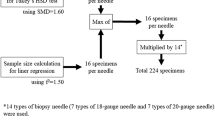Abstract
Purpose
Compare the success of three coaxial fineneedle biopsy techniques in obtaining multiple cytologic specimens of high quality.
Methods
For each of three different biopsy needle and technique combinations (aspiration: 22-gauge Chiba; capillary: 22-gauge Chiba; 22-gauge Autovac aspiration biopsy gun), 30 sites (15 liver, 15 kidney) were selected for coaxial fine-needle biopsy in cadaveric liver and kidneys. For each coaxial technique, three sequential biopsies were performed through an 18-gauge coaxial needle at each of multiple sites. The quality of the resultant 270 specimens was graded by a blinded cytopathologist using a previously published grading scheme.
Results
Using the coaxial technique, there was no significant dropoff in the cytologic specimen quality among the first, second, and third biopsies at a specific site, regardless of the order of the techniques/needles used. This was true for organs, the overall data, and for the individual five grading criteria. There was, however, a significant difference among the biopsy techniques themselves. Though there was no difference in the quality of cytopathologic specimen obtained with the Autovac aspiration gun and the aspiration technique with a 22-gauge Chiba needle, both were statistically better than the nonaspiration, capillary technique utilizing a 22-gauge needle (p = 0.0001).
Conclusion
The use of a coaxial technique with a fineneedle, 22-gauge biopsy offers unique advantages in obtaining a nearly unlimited amount of high-quality material for cytopathologic analysis. In this study, no dropoff was found in specimen quality with subsequent biopsies.
Similar content being viewed by others
References
Moulton JS, Moore PT (1993) Coaxial percutaneous biopsy technique with automated biopsy devices: Value in improving accuracy and negative predictive value. Radiology 186:515–522
Mair S, Dunbar F, Becker P, Plessis W (1989) Fine needle cytology—Is aspiration suction necessary? A study of 100 masses in various sites. Acta Cytol 33:809–813
Ahlström KH, Åström KG (1993) CT-guided bone biopsy performed by means of a coaxial biopsy system with an eccentric drill. Radiology 188:549–552
Dowd PE, Mata JA, Crow A, Culkin DJ, Venable DD (1991) Ultrasound guided percutaneous renal biopsy using an automatic core biopsy system. J Urol 146:1216–1217
Wittich GR, Nowels KW, Korn RL, Walter RM, Lucas DE, Dake MD, Jeffrey RB (1992) Coaxial transthoracic fine-needle biopsy in patients with a history of malignant lymphoma. Radiology 183:175–178
Charboneau JW, Reading CC, Welch TJ (1990) CT and sonographically guided needle biopsy: Current techniques and new innovations. AJR 154:1–10
Akins EW, Hawkins IF, Mladinich C, Tupler R, Siragusa RJ, Pry R (1989) The blunt needle: A new percutaneous access device. AJR 152:181–182
Frederick PR, Miller MH, Bahr AL, Longson FW (1989) Coaxial needles for repeated biopsy sampling. Radiology 170:273–274
Gazelle GS, Haaga JR, Halpern EF (1993) Hemostatic protein polymer sheath: Improvement in hemostasis at percutaneous biopsy in the setting of platelet dysfunction. Radiology 187:269–272
Chuang VP, Alspaugh JP (1988) Sheath needle for liver biopsy in high-risk patients. Radiology 166:261–262
Crummy AB, McDermott JC, Wojtowycz M (1989) A technique for embolization of biopsy tracts. AJR 153:67–68
Fagelman D, Chess Q (1990) Non-aspiration fine needle cytology of the liver: A new technique for obtaining diagnostic samples. AJR 155:1217–1219
Zajdela A, de Maublano MA, Schlienger P, Haye C (1986) Cytologic diagnosis of orbital and periorbital palpable tumors using fine needle sampling without aspiration. Diagn Cytopathol 2:17–20
Santos JE, Leiman G (1988) Non-aspiration fine needle cytology: Application of a new technique to nodular thyroid disease. Acta Cytol 32:353–356
Akhtar M, Ali MA, Huq M, Faulkner C (1989) Fine needle biopsy: Comparison of cellular yield with and without aspiration. Diagn Cytopathol 5:162–165
Zajdela A, Zillhardt P, Voillemot N (1987) Cytological diagnosis by fine-needle sampling without aspiration. Cancer 59:1201–1205
Briffod M, Gentile A, Hébert H (1982) Cytopuncture in the follow-up of breast carcinoma. Acta Cytol 26:195–200
Hopper KD, Abendroth CS, Sturtz KW, Matthews YL, Shirk SJ (1992) Fine-needle aspiration biopsy for cytopathologic analysis: Utility of syringe handles, automated guns, and the non-suction method. Radiology 185:819–824
Author information
Authors and Affiliations
Rights and permissions
About this article
Cite this article
Hopper, K.D., Abendroth, C.S., TenHave, T.R. et al. Multiple fine-needle biopsies using a coaxial technique: Efficacy and a comparison of three methods. Cardiovasc Intervent Radiol 18, 307–311 (1995). https://doi.org/10.1007/BF00203681
Issue Date:
DOI: https://doi.org/10.1007/BF00203681




